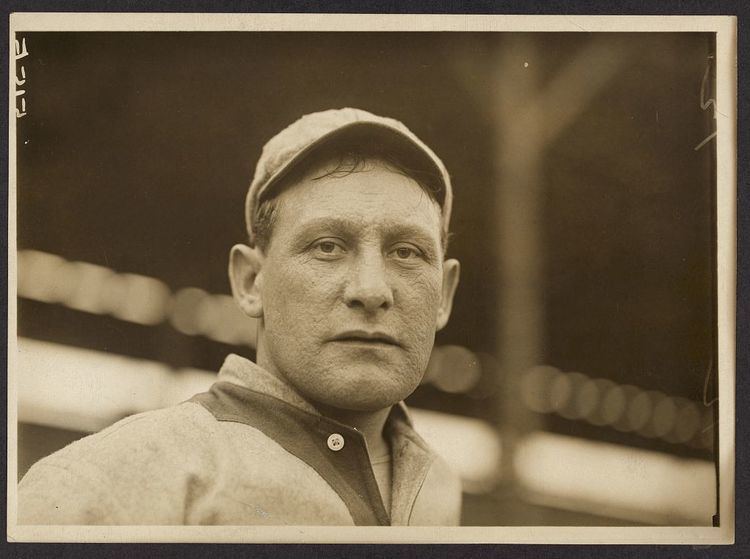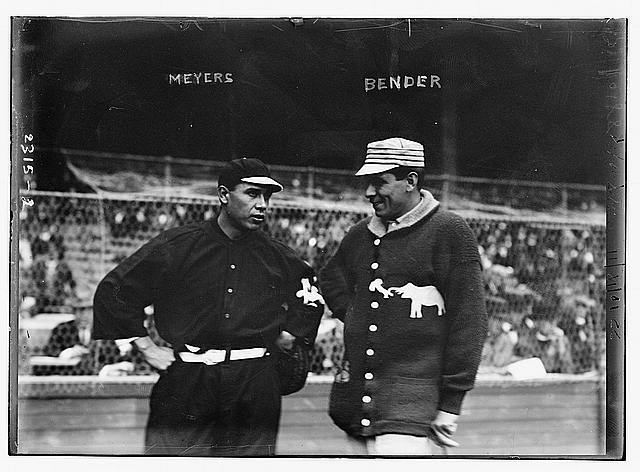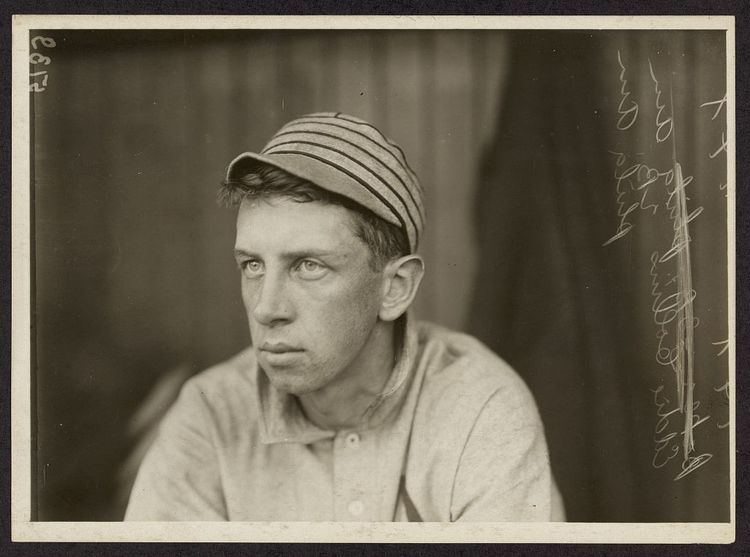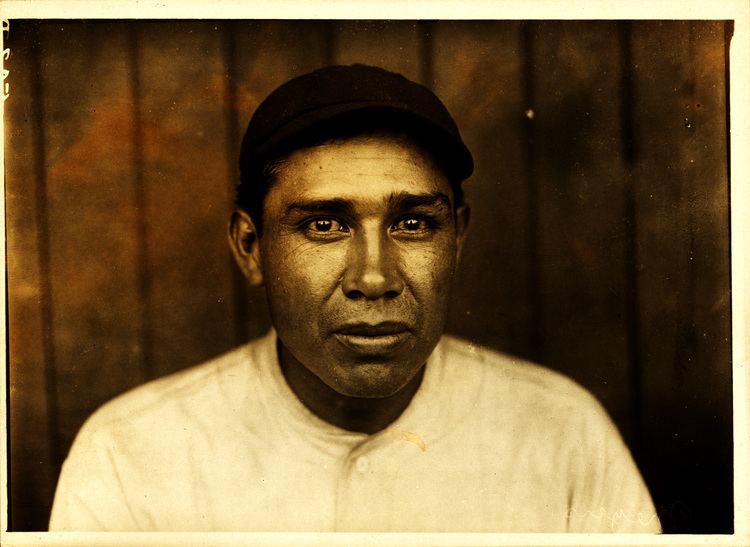Batting average .291 Role Baseball player Name Chief Meyers | Runs batted in 363 Home runs 14 | |
 | ||
Died July 25, 1971, San Bernardino, California, United States | ||
Chief Meyers (July 29, 1880 – July 25, 1971)
John Tortes "Chief" Meyers (July 29, 1880 – July 25, 1971) was a Major League Baseball catcher for the New York Giants, Boston Braves, and Brooklyn Robins from 1909 to 1917. He played on the early Giants teams under manager John McGraw and was the primary catcher for Hall of Famer Christy Mathewson. Meyers hit over .300 for three straight years as the Giants won three straight National League pennants from 1911 to 1913. Overall, he played in four World Series – the 1911, 1912, and 1913 Series with the Giants, as well as the 1916 Series with the Robins. Meyers was a Native American from the Cahuilla culture of California, and he was educated at Dartmouth College.
Contents
- Chief Meyers July 29 1880 July 25 1971
- Overview
- Dartmouth
- New York Giants
- Merkles Boner
- Mathewson and Meyers
- Media
- World War I
- Decline
- References

Overview

Meyers had his greatest success in the 1912 season, hitting .358 and finishing third in the MVP award voting. His .441 on-base percentage led the league. Meyers was also a key player in that year's World Series versus the Boston Red Sox, which featured the infamous "Snodgrass Muff" as well as captivating performances by Mathewson and Smoky Joe Wood. In 1919, Meyers was hired as manager of the New Haven entry in the Eastern League.

Meyers was interviewed by Lawrence Ritter for The Glory of Their Times in March 1964. This brought him a great deal of fame years after he had left baseball.
Dartmouth

Jack Meyers was a Native American playing baseball in the dead-ball era. In the early 20th century, Indians were still stereotyped as stupid, but Chief Meyers belied this stereotype. Meyers was a sophisticated and logical man whose biggest regret was not finishing his college education. At the age of seven, Meyers' father died, causing his mother to become even more important in his life. While playing baseball in a summer tournament, Ralph Glaze, a former pitcher, noticed Meyers' extreme talent and convinced Dartmouth alumni to provide Meyers with cash, railroad tickets, and a doctored diploma. Meyers hadn't graduated from high school, but the fake diploma got him into Dartmouth. While attending classes and playing baseball, the school eventually discovered that his high school diploma was forged. Not wanting to complete a special program to get reinstated into Dartmouth, the 25-year-old catcher signed a baseball contract with an independent league.
New York Giants

After playing a couple years in various leagues, Chief Meyers, 28, was a rookie with the New York Giants in 1908. The following year, the Giants traded away Roger Bresnahan, the best catcher in the league, to the St. Louis Cardinals, which gave the young catcher an opportunity to display his talent, and Meyers didn't disappoint. In 1910, Meyers was hitting .285 making a name for himself throughout the league. Meyers was big and strong, and like the majority of other catchers, wasn't blessed with speed. He hit for power and average. Meyers' most successful season was in 1912, when he batted .358 finishing 3rd in MVP voting. His keen eye lifted his on-base percentage to a league-high .441. Meyers led the Giants in batting for three consecutive seasons. He was a student of the game, predicting pitchers' pitches and location.
Facing elimination against the Athletics in Game 6 of the 1911 World Series, Meyers' Giants trailed 6-1 entering the bottom of the seventh in Philadelphia. After Chief Bender opened the frame with a flyout, two singles and an error by first baseman Fred Merkle fielding a throw on a sacrifice bunt made the score 7-1. Two consecutive singles would score two further runs, then with runners at the corners, Harry Davis hit a 2-1 pitch into right-center to make it 10-1. Continuing the rally, Jack Barry hit a ground rule double into the right field crowd scoring another run and putting runners at second and third, which finally convinced John McGraw to replace his pitcher, Hooks Wiltse, having given up 7 earned runs over 2 1/3 innings. Future Hall of Famer Rube Marquard, who had gone 24-7 that year with a 2.50 ERA and a career-high 237 strikeouts, came into pitch with two runners in scoring position and his team down by ten. His third pitch was so fast and wild that it "dented the screen in the grand stand". Both runners scored on the play because Meyers "refused to chase the ball", instead "glaring at Marquard" in obvious frustration. After a "heated conference" between the battery mates near home plate, order ensued, but the next batter promptly singled off Marquard. The emotional and adrenaline-fueled Meyers then threw out the runner trying to steal second base, stopping the rally. The next batter struck out, ending the inning, although the 11-run lead would prove enough to secure a championship for Philadelphia.
"Merkle's Boner"
Meyers and the Giants lost the pennant in 1908 due to "Merkle's Boner." Fred Merkle, one of the smartest players in the league, forgot to touch second base and the Giants lost due to this technicality. Merkle was regarded as a smart baseball player and was the only player that Manager McGraw would talk strategy with.
Mathewson and Meyers
Meyers was the primary catcher for Hall of Fame pitcher Christy Mathewson. In only two years of playing Major League Baseball, Meyers teamed up with the great Christy Mathewson, putting on a sketch entitled "Curves." The half-hour sketch included both Mathewson and Meyers explaining the art of their position. This wasn't the only project they teamed up for, as both Mathewson and Meyers would act in another sketch which toured for several weeks.
Media
The media displayed affection for the Native American ball player because he was interesting and original. On off-days or rain outs, Meyers would visit historical monuments, watch local college teams practice, and frequently visited museums and exhibits.
World War I
Meyers' grave marker indicated he served as a private in the United States Marine Corps during World War I.
Decline
At the age of 35, Meyers performance started to decline as he batted just .232, and Giants placed him on waivers. Meyers claimed to the teams that he was younger than he actually was. After getting cut in 1918, Meyers joined the Buffalo Bisons. He became a player-manager for New Haven in the Eastern League the following year. After getting replaced by Danny Murphy, Meyers' last stop in baseball was catching for a semipro team in San Diego in 1920. After getting booed at a semipro baseball game, Meyers decided to quit baseball and became a police chief for the Mission Indian Agency. He died in 1971 and was interred at Green Acres Memorial Park in Bloomington, California.
